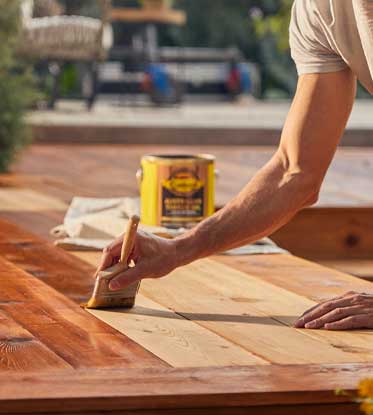
How To Best Protect Your Deck
Avoid major issues from your deck’s exposure to the elements
Just as you decorate and care for the inside of your home, your outdoor space is a reflection of your personality and lifestyle—and you work hard to make sure it is perfect. Understanding how different weather can affect your exterior wood helps determine when is best to clean and stain a deck, ensuring your exterior surfaces are protected and ready to look their best no matter the season.
Whether your deck or other wood surfaces are newly constructed or many years old, proper care and the right stain products can help you avoid mold, mildew growth, peeling and fading—and can make your wood surfaces safe and beautiful.
- Mold & mildew
- Fading
- Peeling
Deck mold and mildew thrive in damp, dark weather conditions. Where possible, remove overhanging branches, fallen leaves, debris from trees, furniture and grill covers, planers and more that block sunlight from reaching your deck.
If you’re unable to remove those pesky “deck-blockers” we just mentioned, it’s important to waterproof your deck in order to prevent mold and mildew growth. Make sure your deck surface is clean, porous and free of any previous finishes so that you can apply our Cabot® Clear Wood Protector.
To ensure an even coating of waterproofing solution, apply with nylon or polyester bushes, stain pads, low-pressure garden sprayer or professional spray equipment. Our tool of choice here is the low-pressure sprayer because of its ease of use. Just be sure to back-brush the surface immediately after spraying to ensure even application and color distribution.

The ideal situation for treating your outdoor space is when it’s not too humid outside. Increased humidity can make it very difficult to get your deck dry and for any gloss coating to stick.
It’s important to avoid staining during rainy and snowy days, too. If you stain right before a big rainstorm or snowfall, the stain will wash away and you’ll most likely have to start the job over. When it snows, remove snow just as you would in your driveway—but don’t use a shovel. Instead, use a push broom or leaf blower to prevent peeling and scratching caused by shovels.
Why it happens: too much sunlight
How to prevent it: stain in cooler weather
We’re talking the dog days of summer here, when constant sunlight is beating down on your home and deck, day after day, without any reprieve from clouds or rain. The hot temperatures can cause UV damage to your deck, so you’ll want to prepare and treat it before the weather becomes too unbearable.
If it’s too hot outside (pushing 90 degrees Fahrenheit or above), the stain you’re applying may dry too quickly, creating clumps, lap lines, stop and start lines, (leading to uneven penetration for the stain to protect the wood), brush marks, etc.

When is the best time to stain a deck? We recommend staining in the morning hours of the summer or on a cooler day without direct sunlight. If you live in the Midwest, you understand how brutally hot summers can be. Make sure to take our tips into consideration and follow these couple of next steps so you can enjoy your deck and outdoor living space all summer long!
To protect your deck from fading, make sure the surface is clean (just like we shared above), structurally sound and completely dry. Cabot® Semi-Solid Deck and Siding Stain is a deep-penetrating oil-based stain that provides long-lasting beauty and wood protection. With special super-fine pigments, this stain is incredibly durable and helps protect your deck against the sun’s damaging UV rays. That means less fading and more enjoyment of your outdoor space!
Stir the stain thoroughly and use a high-quality pad applicator or stain brush to apply to small sections. Start at one edge and follow through to the end of each board to ensure even coating.
Our pro tip? New, unseasoned, smooth wood should be allowed to weather sufficiently before staining, but no longer than three months.
Why it happens: improper stain application or wrong choice of stain
How to prevent it: ask an expert to help you choose the product!
The No. 1 reason why your wood deck is peeling is due to improper stain penetration and protection. This could come from over-applying your stain, poor quality of stain or incorrect choice of stain. A peeling deck can even be caused by high moisture content (refer back to the first section on protecting your deck from mold and mildew).
So, how can you fix the unappealing look? Remove all peeling stain by either stripping, scraping, sanding or power-washing the area. After the surface has been thoroughly prepared and is dry, apply DeckCorrect™ by Cabot. This DIY-friendly formula helps coat your deck evenly with gorgeous coloring, locks down splinters, fills cracks, provides a mold- and mildew-resistant coating, resists dirt and resists cracking and peeling for YEARS!

DeckCorrect™ requires a two-coat application, so be ready to take the time to do so. Shake and stir thoroughly before using and work in small sections at a time with a nylon/polyester brush before rolling. We recommend using a 3/8-inch nap roller to apply a thick, even coat, rolling lengthwise along each board.
You must allow your deck to dry for 4-6 hours before applying the second coat. Do not apply in direct sunlight or in wet conditions. For more on how to keep your deck from peeling, check out all the features of DeckCorrect™.
Peeling Tape Test
To find where wood is peeling, use pieces of masking tape on dry wood. Simply press adhesive tape on the surface with thumb pressure, then remove the tape with a jerking motion. If the coating is removed with the tape, the peeling is more extensive than just the areas that are obvious. This test should be performed in several locations on the siding, deck or other affected areas.
What else can I do to protect my deck?
Be mindful of how you tend to your deck between stains. Check for any overhanging branches from trees, as falling twigs can scratch the deck’s surface and falling leaves can stick to the deck’s surface when wet, leaving stains. If birds have left behind unpleasant surprises from the sky, always use a hose to spray away the mess as soon as possible. Do not scrape with harsh tools, if you can help it.
Seal your deck, keep it clean, stain and re-stain when you notice it needs a touch-up. It’s important to remember to use a high-quality stain. The more opaque the stain (more pigment in the finish to block UV rays), the less re-staining you’ll need to do. The less opaque the stain, the more re-staining you’ll need to do. Keep this in mind when taking into consideration the aesthetic you’d like to achieve and the upkeep you’d like to have to do.
The right stain can provide rich coloring and long-lasting protection from the elements. Remember when to stain your deck and avoid too cold or too hot temperatures (the ideal temperature to stain your deck is between 50-80 F) or too wet conditions, and it will lead to much less upkeep in the future.
Follow these tips to protect your deck from mold and mildew growth, fading and peeling. At Cabot, we offer high-quality waterproofing and staining solutions for your deck and other exterior wood stain projects. Check out our line of products and how you can get started, today!
